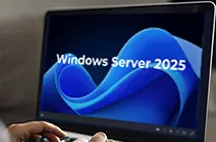Mastering Windows Server 2025
Offline or Online Windows Server 2025 training course.
Windows is one of the basic operating systems that you should know if you’re pursuing a career in IT. Whether you’re just starting your career or looking to advance in your existing IT field, it is always beneficial to start with Windows.

Manoj S. Mahajan
28+ years Experienced Trainer with 100+ certs, View full profile....Course Description
 This course will help you get started with the latest Windows Server version, Windows Server 2025 domain administration, systematically taking you through the essential concepts and techniques. With many hands-on demos, your trainer Manoj will cover the many roles, features and functions of the Windows Server 2025.
This course will help you get started with the latest Windows Server version, Windows Server 2025 domain administration, systematically taking you through the essential concepts and techniques. With many hands-on demos, your trainer Manoj will cover the many roles, features and functions of the Windows Server 2025.
Audience: IT Administrators (Beginner to Intermediate)
Goal: Starting with Windows Server installation and basic configuration, you will learn the Active Directory (ADDS) domain user management, PowerShell, AD trust, FSMO roles, GPO (Group Policies), File server, Server storage and many more topics. You'll learn different Server roles like DHCP, DNS, ADCS and IIS.
Prerequisites
- Some experience in Windows client OS management
- Networking knowledge such as OSI Model theory, TCP/IP configuration.
- Recommended: Windows Essentials and Networking Essentials free webinars.
Key Features
- Real-time 1 to 1 interaction
- Download short notes
- Get the source code after each lecture
- Get an attendance certificate

Syllabus
Please check the syllabus tab above. ☝What You'll Learn
Installing Windows Server 2025
Review system requirements Comparison of Standard and Datacenter editions of Windows Server 2025 Installing Windows Server 2025 Using Server Manager to configure basic Server settings
Installing simple Active Directory (ADDS) (AD in single domain environment)
Understanding Roles and Features Installing and configuring ADDS Setting new domain environment Verifying Active Directory configuration Connecting Windows 10 Client or Member servers in the domain
Managing AD objects
Create and manage users and computers Create and manage groups and organizational units (OUs) Configuring organizational units (OUs) delegation Using Active Directory Admin Center Recovering deleted objects using AD Recycle bin
Managing Server Storage
Determine when to use NTFS and ReFS File Systems Understanding volume types (RAID Levels) Configure RAID Levels Configure storage pools/spaces Implement and configure Data Deduplication Configuring File Sharing and NTFS permissions Configure NTFS permissions Configure NTFS Disk Quotas for users
Implementing Core Networking: DHCP and DNS roles
Understanding DHCP DORA steps Install and configure DHCP server (Scope types, Options, DHCP reservation, Policies and Filters) Backing up & Restoring the DHCP database Install and configure DNS servers Understanding zone types Create and configure DNS zones and records Configure Zone properties Configure AD integrated zones Configure forwarders, root hints and recursion
Implementing Complex AD environment (AD in single domain environment)
Understanding AD environment for enterprise setup Understanding Multiple DC's, Active Directory Domain Tree and Child domains Implementing Additional DC's Implementing Child domains Understanding and configuring different AD trust types
Managing Active Directory database
Configure multiple user principal name (UPN) suffixes Configure a global catalog server Transfer and seize operations master roles (FSMO) Perform metadata cleanup Configure domain and forest functional levels Configure AD DS sites and subnets
Implement and manage Group Policy Objects (GPOs)
Create and manage Group Policy Objects Back up, restore, import, and copy GPOs Configure processing order and precedence Force a Group Policy update Configure Group Policy settings Configure administrative templates Configure account policies Configure and apply Password Settings Objects (PSOs)
Monitor and maintain Server Environment
Create and manage Group Policy Objects Monitor workloads using Performance Monitor Configure data collector sets Overview of the Event Viewer Monitor workloads using Resource Monitor Using Windows Server Backup (WSB) to back up and restore data Back up and Restore Data and AD environment

Sachin
Training was excellent with good interaction. Knowledge sharing is good. Recording facility is excellent for revising. Course was practically and informative. Manoj Sir is enthusiastic and really aware of what he is explaining. The course helped to build confidence, Valuable experiences and learning. Read more....

Prashant
It was a really very good experience. All the details covered by sir is really great. Every smallest information was well explained by sir. I am really thankful to sir. Read more....

Bahumol
I really like this course, training environment and seating arrangement very good. Read more....





